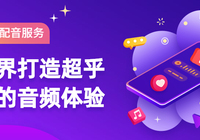手机如何中英文翻译,文字配音视频中英文对照,老铁们想知道有关这个问题的分析和解答吗,相信你通过以下的文章内容就会有更深入的了解,那么接下来就跟着我们的小编一起看看吧。
手机如何中英文翻译,文字配音视频中英文对照

引言:
手机已经成为人们生活的必需品之一。随着全球化进程的加速和科技的不断发展,手机中英文翻译和文字配音视频中英文对照的需求日益增加。本文将系统地介绍手机如何进行中英文翻译以及文字配音视频中英文对照的方法和工具。
正文:
一、中英文翻译方法
中英文翻译是将中文文字转化为英文文字的过程。手机提供了多种中英文翻译方法,其中最常用的是在线翻译工具和语音识别翻译工具。
在线翻译工具一般是指通过手机应用或网页平台实现的翻译功能。用户只需在输入框中输入中文内容,然后选择翻译语种为英文,即可获得相应的英文翻译结果。这种方法简单方便,适用于简单句子和常用词汇的翻译,但对于复杂句子和专业术语的翻译效果有限。
语音识别翻译工具则是通过语音识别技术将中文语音转化为英文文字的过程。用户只需通过手机的语音输入功能说出中文内容,然后选择进行语音识别翻译,即可获得相应的英文翻译结果。这种方法适用于口语表达和长句子的翻译,但对于语音识别的准确性和语速要求较高。
二、文字配音视频中英文对照方法
文字配音视频中英文对照是将中文文字和英文文字进行对照展示的过程。手机提供了多种文字配音视频中英文对照方法,主要包括字幕翻译和同声传译。
字幕翻译是将中文文字通过屏幕上的字幕呈现给观众,同时通过配音的方式将英文翻译播放出来。这种方法可以满足观众对于中英文对照的需求,但需要观众同时听、读两种语言。
同声传译是将中文语音通过耳机传递给观众,同时通过手机屏幕上的字幕展示英文翻译。这种方法可以满足观众对于中英文对照的需求,同时减轻观众的听力负担,但对于字幕的实时同步有较高的要求。
比较:
中英文翻译和文字配音视频中英文对照在方法上有所不同。中英文翻译主要使用在线翻译工具和语音识别翻译工具,而文字配音视频中英文对照则主要使用字幕翻译和同声传译。
在线翻译工具和语音识别翻译工具的优点是操作简单、快捷高效,适用于日常生活中的简单句子和常用词汇翻译。但对于复杂句子和专业术语的翻译效果有限,需要人工修正。
字幕翻译和同声传译的优点是提供了中英文对照的视听效果,方便观众同时理解两种语言。在实际应用中,字幕翻译需要观众同时听、读两种语言,增加了观看的难度;而同声传译对于字幕的实时同步有较高要求。
结尾:
随着全球化进程的加速和科技的不断发展,手机中英文翻译和文字配音视频中英文对照在交流和理解中扮演着重要的角色。通过在线翻译工具和语音识别翻译工具,我们可以快速方便地进行中英文翻译;通过字幕翻译和同声传译,我们可以获得中英文对照的视听效果。在实际应用中,我们需要根据实际需求选择合适的方法和工具,以提高翻译质量和观看体验。
参考词汇:
1. 中英文翻译 - translation between Chinese and English
2. 文字配音视频中英文对照 - text-to-speech video with Chinese and English subtitles
3. 在线翻译工具 - online translation tools
4. 语音识别翻译工具 - voice recognition translation tools
5. 字幕翻译 - subtitle translation
6. 同声传译 - simultaneous interpretation
手机如何中英文翻译

手机如何中英文翻译
引言:
手机作为现代人们生活的必备工具,已经在全球范围内普及和应用广泛。随着全球化的发展,不同语言之间的交流需求也日益增加。手机中英文翻译的能力成为了一项重要功能。本文将从定义、分类、举例和比较等角度,系统地阐述手机如何实现中英文翻译的相关知识。
正文:
手机中英文翻译可以分为两种主要类型,即基于在线翻译服务的翻译功能和基于本地翻译引擎的翻译功能。
在线翻译服务是指手机通过连接互联网,使用在线翻译平台提供的翻译功能进行实时翻译。这种方式的优势在于实时性和全面性。用户可以随时随地获取最新的翻译结果,并且可以翻译各种不同领域的文本,包括新闻、论文、商务文件等。在线翻译服务也存在一些局限性,比如对于私密和敏感的信息,用户可能不愿意通过互联网进行传输。
另一种类型是基于本地翻译引擎的翻译功能。这种方式通过在手机上安装翻译引擎,将翻译数据保存在本地,实现离线翻译。离线翻译具有较强的隐私保护性,用户无需连接互联网即可进行翻译。离线翻译的缺点在于更新速度和适应性。用户需要定期更新翻译引擎以获取最新的翻译结果,并且针对某些特定领域的专业术语,离线翻译引擎可能无法提供准确的翻译。
举例来说,目前市场上流行的在线翻译服务有谷歌翻译、百度翻译等,它们通过连接互联网,利用云端计算资源进行翻译。这些平台拥有庞大的翻译数据库和强大的机器学习算法,能够提供高质量的翻译结果。而基于本地翻译引擎的手机应用如有道翻译、金山词霸等,它们将翻译引擎和离线词典嵌入到手机应用中,用户可以在无网情况下进行翻译。
还有一些手机制造商在手机系统层面上提供了中英文翻译的功能。苹果手机的Siri、华为手机的HiVoice等,这些AI助手可以通过语音输入和输出实现中英文的语音翻译。这种方式便捷快速,特别适合日常口语交流的场景。
结尾:
手机如何中英文翻译,目前已经有多种不同方法和应用。在线翻译服务和基于本地翻译引擎的翻译功能是主要的方式。在线翻译服务通过连接互联网实现实时翻译,而本地翻译引擎则提供了离线翻译的选择。手机制造商也在系统层面上提供了中英文翻译的功能。用户可以根据自己的需求选择适合的翻译方式,并利用手机翻译功能方便地进行中英文交流。
参考译文:
How Mobile Phones Translate between Chinese and English
Introduction:
Mobile phones have become an essential tool in modern life, widely used and popularized around the world. However, with the development of globalization, the demand for communication between different languages has also increased. Therefore, the ability of mobile phones to translate between Chinese and English has become an important feature. This article will systematically explain the relevant knowledge of how mobile phones achieve Chinese-English translation using methods such as definition, classification, examples, and comparisons.
Main Body:
Chinese-English translation on mobile phones can be divided into two main types: translation based on online translation services and translation based on local translation engines.
The online translation service refers to the mobile phone using real-time translation provided by online translation platforms by connecting to the Internet. The advantage of this method lies in its real-time and comprehensive nature. Users can access the latest translation results anytime and anywhere, and can translate various types of texts, including news, papers, and business documents. However, online translation services also have some limitations, such as the potential reluctance of users to transmit private or sensitive information via the internet.
Another type is translation based on local translation engines. This method involves installing translation engines on the mobile phone, storing translation data locally, and enabling offline translation. Offline translation provides stronger privacy protection as users do not need to be connected to the Internet for translation. However, offline translation has disadvantages in terms of update speed and adaptability. Users need to regularly update the translation engine to obtain the latest translation results, and offline translation engines may not provide accurate translations for certain specific fields or professional terminology.
For example, popular online translation services on the market include Google Translate and Baidu Translate, which use cloud computing resources to provide translation by connecting to the Internet. These platforms have large translation databases and powerful machine learning algorithms, enabling them to provide high-quality translation results. Local translation engine-based mobile applications such as Youdao Translate and Kingsoft PowerWord, on the other hand, embed translation engines and offline dictionaries into the mobile app, allowing users to translate without an internet connection.
In addition, some mobile phone manufacturers provide Chinese-English translation features at the system level. For instance, Apple's Siri and Huawei's HiVoice are AI assistants that can achieve Chinese-English voice translation through voice input and output. This method is quick and convenient, especially suitable for daily spoken communication.
Conclusion:
Various methods and applications exist for Chinese-English translation on mobile phones. Online translation services and translation based on local translation engines are the main approaches. Online translation services achieve real-time translation by connecting to the internet, while local translation engines provide the option for offline translation. Additionally, mobile phone manufacturers also provide Chinese-English translation features at the system level. Users can choose the translation method that suits their needs and conveniently communicate in Chinese and English using the translation capabilities of mobile phones.
中英文实时翻译器

中英文实时翻译器是一种能够即时将中文和英文互相翻译的工具。它的出现为各行各业的国际交流提供了便利,同时也为个人提供了更加便捷的翻译服务。本文将通过定义、分类、举例和比较等方法,系统地介绍中英文实时翻译器的相关知识。
中英文实时翻译器可以根据语音或文本输入,进行语言的即时翻译。根据其功能和应用领域的不同,可以将中英文实时翻译器分为两大类:软件和硬件。软件翻译器是安装在手机、平板电脑或电脑等设备上的应用程序,如谷歌翻译、百度翻译等。而硬件翻译器则是一种独立设备,如腾讯的“即翻笔”等。这些翻译器可以翻译语音、文字和图像等多种形式的输入内容。
举例来说,谷歌翻译是一种常用的中英文实时翻译软件。它可以通过语音输入或者手动输入文本进行翻译。该软件使用了机器学习和人工智能技术,能够自动识别语音并翻译成目标语言,同时还提供了实时的文字翻译和图像翻译功能。而硬件翻译器“即翻笔”则是一款方便携带的独立设备,可以通过手写输入或者语音输入进行翻译,同时还支持实时翻译和离线翻译。
中英文实时翻译器的出现给人们的生活和工作带来了很多便利。在旅游和商务交流中,它可以帮助人们快速翻译交流内容,解决语言障碍。在学习和研究中,它可以帮助人们更深入地了解和学习外语知识。在跨国公司和国际会议中,它可以促进各方之间的沟通和合作。中英文实时翻译器还可以帮助人们学习外语发音和语法,提高语言能力。
与传统的翻译方式相比,中英文实时翻译器具有许多优势。它具有即时性,能够在几秒钟内完成翻译任务,大大提高了效率。它可以识别并翻译多种输入形式,如语音、文字和图像等,使翻译更加便捷多样。中英文实时翻译器使用了先进的技术,如机器学习和人工智能,能够自动学习和优化翻译质量,减少了人工翻译的错误和主观性。中英文实时翻译器还可以提供发音指导、语法解析等辅助功能,帮助用户更好地理解和学习语言。
中英文实时翻译器是一种功能强大、便捷高效的工具,为各行各业的国际交流提供了便利,同时也为个人提供了更加便捷的翻译服务。随着科技的不断发展和创新,中英文实时翻译器在未来的应用前景将会更加广阔。我们期待着更多智能化、个性化的中英文实时翻译器的出现,为人们的交流带来更多的便利和可能性。
手机如何中英文翻译,文字配音视频中英文对照的问题分享结束啦,以上的文章解决了您的问题吗?欢迎您下次再来哦!
免责声明:以上整理自互联网,与本站无关。其原创性以及文中陈述文字和内容未经本站证实,对本文以及其中全部或者部分内容、文字的真实性、完整性、及时性本站不作任何保证或承诺,请读者仅作参考,并请自行核实相关内容。(我们重在分享,尊重原创,如有侵权请联系在线客服在24小时内删除)
-
 什么是配音,男孩入门英文配音48人浏览
什么是配音,男孩入门英文配音48人浏览 -
 再来英语怎么说,他不会再回来了英文配音74人浏览
再来英语怎么说,他不会再回来了英文配音74人浏览 -
 人工智障爱谁配音,AI配音英文转中文85人浏览
人工智障爱谁配音,AI配音英文转中文85人浏览














